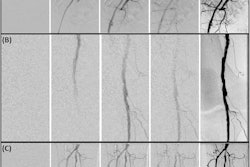 Erin Stephens.
Erin Stephens.
The importance of accurate and complete coding cannot be overemphasized for any area of radiology, but the complexity of interventional radiology (IR) coding makes it even more critical for optimal reimbursement. The prerequisite for complete coding is thorough documentation that includes all required elements, along with a coding team that is highly trained in IR.
The coding team
There are specialty credentials for IR coding, and your team should consist of IR specialists just as you have specialty-trained IR physicians. The American Academy of Professional Coders (AAPC) issues the Certified Interventional Radiology Cardiovascular Coder (CIRCC) designation, and the Radiology Business Management Association (RBMA) issues the Radiology Coding Certification in Interventional Radiology (RCCIR) credential.
Just as physicians undergo continuing medical education, your coders should also be updated annually and have reference materials available to them. Webinars are frequently made available by both credentialing organizations mentioned.
Coding involves not only procedural (CPT)1 but also diagnosis (ICD)2 coding. These code sets include vast amounts of information, and your coding team should have readily available, annually updated reference material. The use of both internal and external audits will serve to reinforce training and provide assurance to the practice that the team is performing optimally.
External audits are done less frequently and will include a full cross-section of the practice’s procedure mix. Internal audits can target specific areas of concern, such as high-dollar or complex procedures, as well as the work of coders who are new to the practice.
It is essential that the coders have the availability of a system that allows them to send any report back to the physician with questions or to supply missing information. This not only assures accurate coding of the specific patient procedure, but it provides feedback to the physicians so they can improve their documentation.
An administrator should monitor the system to ensure that requests are addressed in a timely manner. It is especially important to monitor the documentation provided by physicians new to the practice. A review of new physicians can be the subject of a targeted internal audit.
As the coding team receives its annual education, they must pass along any changes to coding or documentation requirements to the physicians and to the team responsible for insurance authorization. Bundling of procedures can change quarterly and those changes have to be analyzed to determine whether they will have an impact on reimbursement.
Complete and comprehensive coding
We recommend that a procedure be coded as completely and accurately as possible, without regard to whether a particular payer will provide reimbursement for certain codes. The data provided on nonpayment can be used in future contract negotiations with the payer.
In addition, payers sometimes change their edits without notification and a completely coded claim will have the opportunity for payment immediately if that occurs. Thoroughly coded claims also capture the full value of wRVU (work relative value units) that are used to measure a physician’s productivity within the practice.
When using modifiers that allow two codes to be used together, it is vital that the documentation supports the reason for both codes. Frequent use of modifiers can trigger a payer audit that requests documentation, with potential penalties for inappropriate use.
Complete diagnosis coding is as important as complete procedure coding. Certain primary diagnoses are only payable with an acceptable secondary diagnosis. As an example, “diabetic ulcer” must have both ICD codes E11.621 (type 2 diabetes mellitus with foot ulcer) and L97.523 (nonpressure chronic ulcer of other part of the left foot with necrosis of muscle) in order to comply with payer policies.
Providing the highest level of specificity is always preferred. Some payers have announced that they will deny payment for claims where the laterality of the diagnosis is not specified.
Quality Payment Program (QPP) considerations
While coding for Medicare’s Merit-based Incentive Payment System (MIPS) is not unique to interventional radiology, it is critical to receiving the maximum reimbursement. Unless the practice is a member of an Accountable Care Organization (ACO) or other Alternative Payment Model (APM), reporting under MIPS is essential in order to avoid a 9% payment penalty from Medicare.
The challenge for IR is to find measures that apply to their procedures as the number of available measures has continued to decrease over recent years. One solution is to consider reporting through a Quality Clinical Data Registry (QCDR) such as the one maintained by the American College of Radiology (ACR). QCDR’s offer more measures that are tailored to a particular specialty. This is especially attractive to large practices of 16 or more eligible clinicians.
Top 3 underdocumented IR procedures
Thorough documentation is the basis for maximal coding and reimbursement. When we audit documentation for interventional radiology, there are certain procedures where we consistently see deficiencies. Without correction, those procedures would represent lost revenue from the failure to bill for all of the possible procedure codes, as well as opening the practice up the possibility of a compliance risk if the codes were billed without supporting documentation.
Vascular ultrasound guidance
A complete report includes evaluation of the potential access sites, documentation of selected vessel patency, concurrent real-time ultrasound visualization of vascular needle entry, and permanent recording and reporting. In the example that follows, the inadequate report does not document that the images were permanently stored in the patient’s record.
| Adequate Documentation |
Inadequate Documentation |
|---|---|
| A localizing sonographic evaluation of the right neck was performed. Images were saved as part of the patient's permanent medical record. Localizing sonographic evaluation demonstrated the right internal jugular vein to be patent and normally compressible. There was no intraluminal thrombus. Under ultrasound guidance and using a micropuncture needle, the right internal jugular vein was accessed with ultrasound imaging showing needle positioning within the vein. |
History: Venous access requirement. Technique: The left arm was prepped and draped in the usual sterile manner. Scout sonographic evaluation of the left arm was performed. Images demonstrated a patent brachial vein. Under aseptic conditions, local anesthesia, and ultrasound guidance, the vein was accessed with a micropuncture kit, and a 5 French catheter was placed. The catheter was secured in place and flushed. Findings: Patent right brachial vein. |
Fluoroscopic Guidance
Fluoroscopic guidance is often used for placement, replacement, or removal of central vascular devices, and is increasingly bundled with a variety of IR services. In the example that follows, the inadequate report does not contain documentation of the follow-up imaging that is required to verify the catheter tip position.
| Adequate Documentation | Inadequate Documentation |
|---|---|
| Under fluoroscopic guidance, the catheter was trimmed to an appropriate length and placed through the peel-away sheath. The distal catheter tip was positioned at the upper right atrial level. Follow-up fluoroscopic imaging demonstrates appropriate port catheter positioning with the distal catheter tip positioned at the upper right atrium. There were no kinks along the catheter course. |
The catheter was trimmed to appropriate length and placed into the vein under fluoroscopic guidance via a peel-away sheath. |
Moderate Sedation
While each individual case is not highly reimbursed, over many procedures billing for moderate sedation can add up to a significant amount. Complete reporting must include both the start and stop times, including the total procedure time, affirmation that the radiologist provided direct supervision, and the medications administered. In the example that follows, the inadequate report does not document the medications administered.
| Adequate Documentation | Inadequate Documentation |
|---|---|
| Intravenous conscious sedation was administered by the nurse and supervised by Dr. Smith. The patient was independently monitored by an RN assigned to the department of radiology using automated blood pressure, EKG, and pulse oximetry equipment. The detailed conscious sedation record is permanently stored in the health information system. The following is the conscious sedation medication record, including start and end times: 50 mcg of fentanyl and 1 mg of versed were administered intravenously from 1035 until 1214 hours. | SEDATION: Medications were administered and monitored by the radiology nursing staff with my direct supervision. The moderate sedation was started at 9:30 and given in divided doses throughout the procedure and ended at 10:15. |
Conclusion
The recipe for IR revenue cycle success comes down to four essential ingredients:
- Education, including an awareness of payer policies, coding and documentation guidelines, and other factors that impact reimbursement.
- Communication, ensuring that all providers and staff understand their role in assuring compliance and maximizing revenue.
- Attention to detail, avoiding incomplete documentation, missing codes, or applying incorrect codes.
- Follow through, to be sure denials are handled promptly, and that all internal audits and monitoring processes take place according to the practice’s policies and procedures.
Erin Stephens is senior client manager, education at Healthcare Administrative Partners.
The comments and observations expressed are those of the author and do not necessarily reflect the opinions of AuntMinnie.com.
References:
- Current Procedural Terminology is a copyrighted code set developed and maintained by the American Medical Association, and CPT is a registered trademark.
- ICD stands for International Classification of Diseases, the system owned and copyrighted by the World Health Organization that is used to report diagnoses when submitting claims for reimbursement of physician services, among many other purposes. ICD-10 is the 10th edition of this coding system. CM stands for the Clinical Modification of the classification system.



















